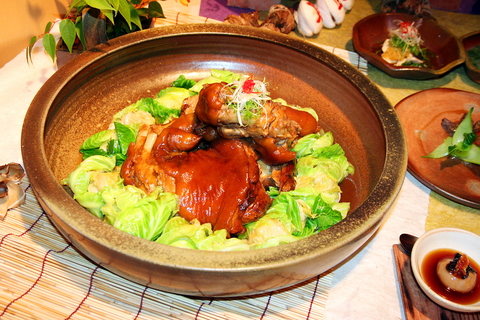"Nouveau Taiwanese cuisine" is a label that was going to stick sometime. Now that it has you can sample traditional and reinvented Hakka dishes by prize-winning chef Robin Lin (林祺豐) at the Shang Palace in the Far Eastern Plaza Hotel (台北遠東國際大飯店). The former mechanical engineering and Chinese cuisine graduate combines attention to detail and a love of food and country.
The result is a piquant and earthy style of cooking that uses local ingredients, such as clams, salty pork, Chinese cabbage, preserved turnip, intestines and fruits of the sea. Lin uses these staple foods to develop "new Taiwanese" recipes based on old formulas.
The Hakka, or "guest people," were originally from northern China, around 1,700 years ago, but settled in the south and then moved outward in a series of diasporas. Most Taiwanese Hakka settled in hilly or remote areas and typically were poor and dependant on farming. As a result their food was often preserved with salt or by pickling, in order to make the most of their seasonal harvests. It was also occasionally oily as this provided much-needed energy.

PHOTO: JULES QUARTLY, TAIPEI TIMES
This was evident in dishes such as the salty pork with preserved turnip and the spicy, salted deep-fried bomb fish. Like spice in an Indian curry or the seasoning originally used by French chefs to disguise indifferent ingredients, Taiwanese fare has evolved its own set of flavors. Preserved been curd sauce is a key element in many of the dishes and has a strong taste that would have originally given bland food some interest.
"Hakka food is generally considered to be common. Here we are making it more cultured and sophisticated so that diners can appreciate the real Hakka spirit. It is food that was originally for poor people but actually it is now considered to be good for the health and natural," Lin said.
An example of this was the clam with fried rice, wrapped with cabbage that came garnished with seaweed. The gently seasoned seaweed and clams went together perfectly and Lin explained choosing elements that complemented each other was a signature of his dishes.
Lin, who won a Hakka cuisine championship in 2005, is head chef at the renowned Hwataoyao (華陶窯) restaurant, botanical garden and ceramic studio in Miaoli County (苗栗縣). For this weeklong promotion at the Far Eastern, Lin will assist the hotel's chefs in providing nouveau Taiwanese cuisine, for the first time.

This month the government ordered a one-year block of Xiaohongshu (小紅書) or Rednote, a Chinese social media platform with more than 3 million users in Taiwan. The government pointed to widespread fraud activity on the platform, along with cybersecurity failures. Officials said that they had reached out to the company and asked it to change. However, they received no response. The pro-China parties, the Chinese Nationalist Party (KMT) and Taiwan People’s Party (TPP), immediately swung into action, denouncing the ban as an attack on free speech. This “free speech” claim was then echoed by the People’s Republic of China (PRC),

Exceptions to the rule are sometimes revealing. For a brief few years, there was an emerging ideological split between the Democratic Progressive Party (DPP) and Chinese Nationalist Party (KMT) that appeared to be pushing the DPP in a direction that would be considered more liberal, and the KMT more conservative. In the previous column, “The KMT-DPP’s bureaucrat-led developmental state” (Dec. 11, page 12), we examined how Taiwan’s democratic system developed, and how both the two main parties largely accepted a similar consensus on how Taiwan should be run domestically and did not split along the left-right lines more familiar in

Many people in Taiwan first learned about universal basic income (UBI) — the idea that the government should provide regular, no-strings-attached payments to each citizen — in 2019. While seeking the Democratic nomination for the 2020 US presidential election, Andrew Yang, a politician of Taiwanese descent, said that, if elected, he’d institute a UBI of US$1,000 per month to “get the economic boot off of people’s throats, allowing them to lift their heads up, breathe, and get excited for the future.” His campaign petered out, but the concept of UBI hasn’t gone away. Throughout the industrialized world, there are fears that

Most heroes are remembered for the battles they fought. Taiwan’s Black Bat Squadron is remembered for flying into Chinese airspace 838 times between 1953 and 1967, and for the 148 men whose sacrifice bought the intelligence that kept Taiwan secure. Two-thirds of the squadron died carrying out missions most people wouldn’t learn about for another 40 years. The squadron lost 15 aircraft and 148 crew members over those 14 years, making it the deadliest unit in Taiwan’s military history by casualty rate. They flew at night, often at low altitudes, straight into some of the most heavily defended airspace in Asia.